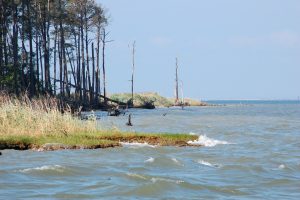9 Conclusion: The Future of Climate Fiction Films

is licensed under CC BY-NC-ND 2.0.
Just yesterday, I read an article in The Guardian about an English couple, Simon and Genny Measures, who are, as the author put it, the country’s “latest climate crisis refugees.” Rising tides and storms are destroying the coast in their village of Hemsby, forcing residents to be permanently evacuated, their picturesque seaside chalets deemed unsafe and demolished by the local government. Another couple, Malcolm Debbage and his partner, Frances Bolton, were one of eleven households in Hemsby to lose their homes during the “beast from the east” in 2018. Debbage states, “The people of Hemsby are unacknowledged victims of climate change”; another resident warned, ““We are the canary in the coalmine. What is happening here could happen to any major coastal community around the UK.”[1] It already is happening elsewhere on our planet.
As the climate crisis accelerates exponentially, I wish I could state that there is no future for Cli-Fi Films because humans will soon manage and even resolve the crisis. But obviously I can’t, and if the increasing numbers of not only films but books and series are any indication, creative grappling of this existential problem to imagine solutions is ramping up. (Tristan Bove in earth.org claims that “[c]limate change fiction officially went mainstream in 2021.”[2]) To wit, some notable examples of books and series from the past few years include:
Books
The Ministry for the Future, by Kim Stanley Robinson
The High House by Jessie Greengrass
Something New Under the Sun by Alexandra Kleeman
The New Wilderness by Diane Cook
Migrations by Charlotte McConaghy
Termination Shock by Neal Stephenson
Diatomea by Núria Perpinyà
A Children’s Bible by Lydia Millet
Streaming and Network Series
Extrapolations (Apple TV+)
Reservation Dogs (Hulu)
Abbott Elementary (ABC)
Grey’s Anatomy (ABC)
The Rig (Amazon Prime)
Frontera Verde (Netflix)
Additionally, as I write this, a polemical new film, How to Blow Up a Pipeline, has arrived in theatres. I have yet to see it, but apparently the heist film — set here in my home state of Texas — considers whether violence against the fossil fuel industry is justified. It reportedly holds up the collaborative activism of the central characters as a successful model for combating climate change. Sounds controversial![3]
In 2014, Noah Gittell in The Atlantic argued that Cli-Fi Films like Interstellar (see Post-Climapocalyptic Dystopias), the subject of the article, come up short in offering solutions to the climate crisis. “Why does Hollywood keep getting the environment wrong? Maybe it’s for the same reasons that politicians have been unable to fix it: Because the ways that climate change and other environmental crises can be addressed are not dramatic or awe-inspiring. The dangers of doing nothing are horrifyingly cinematic, but the solutions are prosaic and dull.”[4] And just last week, Tyler Harper in BBC Culture argued that climate fiction – either literature or film – does more harm than good, its often bleak storytelling and dire warnings sparking a kind of paralysis instead of inspiring readers/viewers to take action. He states, “the genre is also a victim of the unreasonable expectations of both members of the media and academics who insist that “cli-fi” is a form of climate activism,” and points to a lack of evidence that the genre spurs action.[5]
I agree with Harper that we so far lack empirical evidence of the ability of climate fiction to enact change. But I have more faith in the creative abilities of filmmakers (certainly more than I have in politicians) and hold out hope that their work may contribute to solutions to this thorny problem. The imagination is a potent tool, unlimited in its capabilities. With this optimism in mind, I’d like to close this text by turning to a non-Cli-Fi Film and quoting Tom Hanks as Walt Disney (one of cinema’s most brilliant “imagineers”) in Saving Mr. Banks (2013): “ . . . that’s what we storytellers do. We restore order with imagination. We instill hope again and again and again.” Here is to hope, restoring order, saving the planet and its inhabitants – and to the power of the storytellers. May they inspire you to action.

- Barkham, Patrick (April 3, 2023). “‘Losing your home is a massive thing’: how the climate crisis came to Norfolk.” The Guardian. Retrieved April 4, 2023. ↵
- Bove, Tristan (January 14, 2022). “5 Great Climate Change Fiction Novels.” earth.org. Retrieved April 4, 2023. ↵
- Shepard, Susan Elizabeth (April 21, 2023). “A Radical New Eco-Thriller Film Asks: Does the Climate Crisis Justify Blowing Up an Oil Pipeline?” Retrieved April 24, 2023. ↵
- Gitell, Noah (November 15, 2014). “Interstellar: Good Space Film, Bad Climate-Change Parable.” The Atlantic. Retrieved April 4, 2023. ↵
- Harper, Tyler (April 18, 2023). “What The Last of Us, Snowpiercer and 'climate fiction' get wrong.” BBC Culture. Retrieved April 24, 2023. ↵
